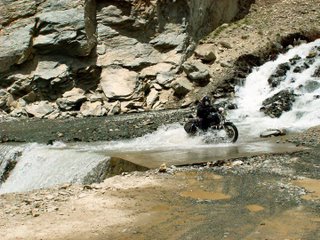Water, water everywhere...

When I was writing the Leh Manual, I was remembering the time when I was preparing to ride the motorcycle into Ladakh. And I think the thing that scared me the most was having to cross streams. It gave me sleepless nights, cold sweats and at least on two occasions, I wondered why I was putting my name in for a motorcycle trip that was so scary in the first place. Yes, I'm quite the scaredy cat.
So I did some research, and it was no surprise that the subject is not often tackled on the internet. Chris Scott does have a book out (here), but again, you have to pay for it, right? So I thought I'd dig my heels in, root for open source, and see what I could come up with, without plagiarising any published work. No, I haven't read Scott's book.
How deep is it?
First of all, the depth of water is not a constant. If the stream is fed by snow/ice, the depth rises with temperature. That means deeper in summer, deeper as the day wears on and so forth. That means a trickle in the morning can be a gush by lunch. So judge the same stream separately when you cross it on your way out, and on your way back.
Walk the talk
Ideally you should be walking across the stream first. This does two things for you. It wets your boots and kit. So when you fall, the wetness and the consequent cold is not a psychological setback. Second, it allows you to read a bit of information on the stream. You're concentrating on the force of the flow, the depth and the surface you're going to traverse. You need to avoid big rocks and big dips to keep your momentum. And to keep the rubber side down. The depth read should also tell you clearly what all you're about to submerge. The exhaust is okay (enough revs will keep water out), an air intake that becomes a marine trinket is not. Also, you're feeling the surface underneath. Sand will cause a possibly splashy loss of traction. Algae (usually only in stagnant or slow flowing water) will cause slides... you get the picture.
Current topic
If the current is strong, enter upstream and plan to exit a bit downstream. You just plan, the water will do the rest for you. Water also happens to push against flat surfaces. And most of your motor, panels, sidewalls all present the very same sort of surface. This means the bike will want to 'slew' sideways as soon as you're past a certain depth. Being prepared for the motion helps.
Mechanical manouvering
No, I still haven't figured out the spelling of manourveriing. No matter. They all say the same thing about the technique. First gear, good speed, high revs and luck. Fast water will rob you of speed. Sand will rob you of speed. Fear will rob you of speed. And don't stop. Standing on the pegs apparently helps. I wouldn't know, I was too scared. And too focussed on the other side to notice. You want to accelerate all the way through. This keeps the weight on the rear wheel, so the front wheel will deflect off any rocks/bumps less than if you were going steady or slowing.
Group therapy
Whatever happens, don't be brave and say, 'I'll go first.' It's not worth making a splash for. Second, ideally, don't cross when you're alone. Wait for someone to come along. A downed bike is a bitch, no two ways about it. A downed bike in a current is almost impossible to pick up. And if the current is fast enough, and deep, it can drag the motorcycle downstream before you can pick a choice obscenity from your sprawling vocabulary. Again if you and your buddies ride different bikes, remember that if his intake is higher than yours, then he can wade deeper than you, so you can't follow his line all the time.
Grease is the word
After the crossing, at leisure, of course, checking the bearing lubes doesn't hurt the bike.
S*it happens
If you do down the bike, ask for help. Don't be shy. You will need to drain water out of everything before the bike will start. This means blowing water out of the engine via the spark plug hole, the exhaust... wherever. Be prepared for prolonged sputtering when it starts. And to kick the freaking life out of the bike before it does start. It helps to shut the engine off if you're sure you're about to fall. It stops the motor from sucking water in thanks to combustion vacuum. So its easier to start once you're through.
Doc Wong (my original post about him is here) has an interesting aside to the right way to drown your bike. See it here. My favourite part of his tip? 'Go in as early as possible (in the morning, that is). Who knows how long you'll be there?'
It's too deep
If the water really is too deep, or too strong. Consider your options. You and a buddy could walk the thing across and start it the other side. Or you could wait for a truck to come along and the carry the bike across. You could also wuss out and head home.
Tell me more
I'm sure there're those of you who have gills on your bikes from the number of times you've crossed water. So this is a call to all of you. Why don't you tell me more about how you cross water? That way, I could post it here, and more people would avoid keeling over midstream. More importantly, I'd wet a whole lot less kit less times, at least appear outwardly to be calm and rugged and maybe even make it across without a proper soaking. Help me, you guys...





















No comments:
Post a Comment